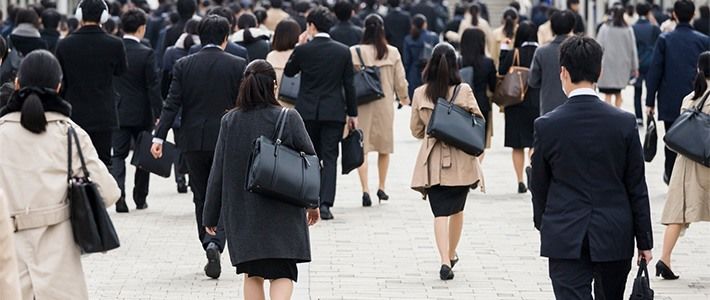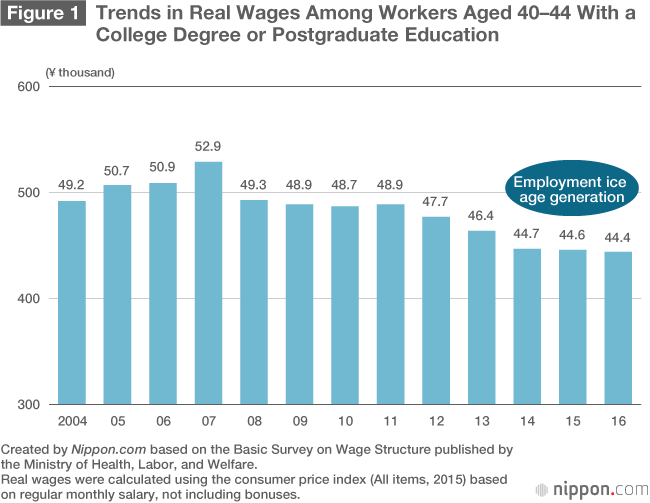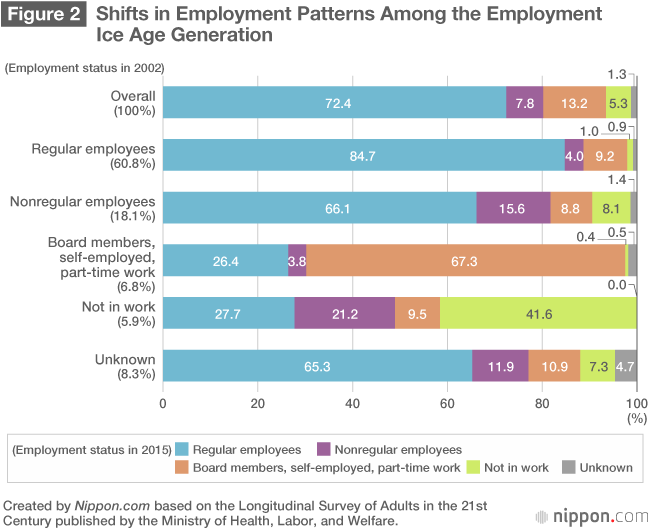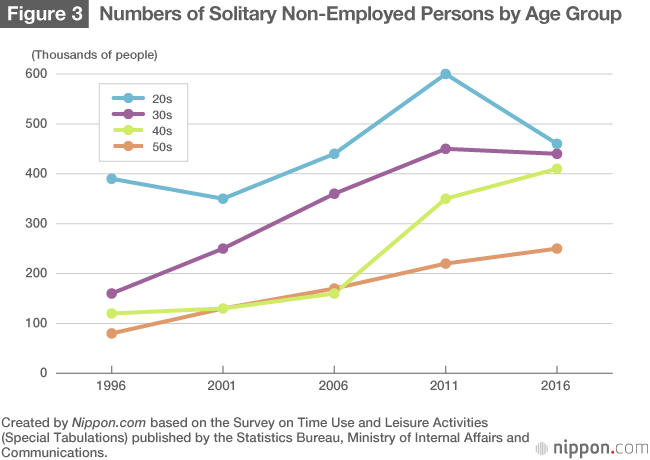
The Lingering Effects of Japan’s “Employment Ice Age”
Work Society- English
- 日本語
- 简体字
- 繁體字
- Français
- Español
- العربية
- Русский
Fleeting Opportunity in Corporate Japan
Get on board any Tokyo subway in the springtime months, and you’re likely to encounter a sight that has become as much a part of the seasonal landscape as cherry blossoms and spring showers: young people hunched uncomfortably in brand new suits, staring intently at their smartphones or checking frantically over the documents in their hands.
Some of these young people are likely to be among those who graduated in March and entered their new companies in April. But more numerous, and standing out even more endearingly in their youthful vulnerability, are those who are still in college—job-hunting students engaged in the search for a company that will take them on after graduation a year from now.
The suits they wear for this job search are known in Japan as “recruit suits.” Plain and unprepossessing, these simple black or dark blue outfits might have been deliberately designed to snuff out any attempt to assert the individuality of the wearer. Companies are looking for malleable raw material that can be molded and trained in the years to come, and the recruit suit acts almost like a guarantee to potential employers that the person within can be trusted to buckle down and adapt to the company culture without attempting to rock the boat.
There is a reason why students take these job searches so seriously. They know that the success or failure of this first job hunt may well have a decisive impact on the rest of their lives.
Part of the reason for this is to be found in the distinctive Japanese hiring system. Traditionally, the standard practice at most firms has been to hire new recruits straight out of school as regular permanent employees (seishain), and then to provide these employees (particularly the men) with careful, long-term training over the early years of their career. Assuming they make it through these years of apprenticeship, these male seishain can then look forward to all the benefits that come from a more-or-less guaranteed job till retirement and steadily increasing seniority-based pay, their income increasing over time in line with their growing skills and experience. At least, that’s how the system works in theory.
The downside of this system, however, is that anyone who fails to hitch a ride on board the narrow rails prepared by companies for new graduates is likely to face serious difficulties in later years. Since most companies prefer to hire new seishain immediately out of college, anyone who misses out on this early opportunity will find it extremely difficult to find a regular position in the future. This leads to knock-on consequences that can adversely affect these workers’ careers and lives in general.
In this respect, students engaged in their job searches now, in the context of an ongoing labor shortage, can consider themselves fortunate indeed. Although today’s students no doubt experience all the usual feelings of trepidation as they search for a suitable employer, the huge numbers of open positions and companies looking to make new hires mean that substantial numbers of lucky job-hunters this year will have the pleasant surprise of being able to choose from multiple offers. By the summer, these lucky students should be able to shuck off their “recruit suits” and kick back to make the most of one last summer vacation before they begin their careers.
But around 15 years ago, many young people found themselves in exactly the opposite situation. Back then, there simply weren’t enough positions to go around. An ongoing economic slump meant that most companies had cut back on hiring, and many people found it impossible to get even a single job offer, no matter how hard they looked. Considerable numbers gave up in despair and abandoned any hope of ever finding a decent position.
The generation of young people who graduated during Japan’s so-called lost decade, which lasted from the late 1990s through the first half-decade of the new century, found it extremely difficult to find good jobs. They had the misfortune to come of age during what has become known as the “employment ice age.” Today, this generation is entering its late thirties and mid-forties, and many are still stuck in an extremely difficult situation.
The Decline and Fall of the Japanese Pay Packet
Figure 1 shows the shifts in average monthly salary earned by people aged 40 to 44 with a college degree or postgraduate education. The figures reflect real wages, adjusted for changing prices, and show how much the pay packet of each cohort was worth in real terms in 2015 money.

From 2005 until 2007, just before the world financial crisis, the average salary was over ¥500,000 a month. At current exchange rates, this comes to a little under US$5,000 per month, quite a high total. People then in their early forties had graduated and joined the workforce at a time when Japan was still luxuriating in the bubble economy. This bubble generation did not normally struggle to find decent jobs, and once they started their careers they were protected by the traditional Japanese employment system and its guarantees of long-term employment and seniority-based pay.
But 2008 marked a turning point. That year, real wages fell below ¥500,000 a month. They have continued to fall considerably since then. By the middle of the second decade of the new century, most workers in their early forties were people who had left college during the employment ice age. Their average monthly pay is less than ¥450,000 (around US$4,200)—more than ¥50,000 less than the average earnings of the lucky bubble generation. These people are now at the time of life when consumption should be at its height, when they are likely to be bringing up children, and investing in substantial purchases like cars and property. But the money is simply not there. The ice age generation includes those born between 1971 and 1974, the children of the baby boomers, who themselves represent a significant chunk of the population. This means that stagnant consumption among this cohort has a commensurately large impact on the whole economy. It is hard to see how serious progress can be made on breaking out of the deflationary spiral while the situation remains as it is.
A sizeable proportion of the ice age generation failed to find a satisfactory job at their first attempt, and as a result many of them have changed jobs at least once in the course of their careers. This necessarily means that they have served fewer years with their present companies than would normally be the case under Japan’s traditional “lifetime employment” system. Since it is still the norm in Japan that pay increases incrementally to reflect an employee’s longevity with the company, this naturally results in lower salaries for many. Unlike their counterparts in the bubble generation—who often lucked into high-paying jobs with major corporations—many of the ice age generation had to settle for jobs with small or medium-sized enterprises. Even if they have remained with the same company ever since, the large cohort of workers from the bubble generation above them means that these ice age hires find it difficult to get promoted to managerial roles. These reasons pile up and compound each other to create an employment structure that for many in this generation means that pay is failing to increase as they get older.
Reducing the culture of long working hours is a major aim in Japanese society today. When the ice age generation were in their twenties, the idea of sābisu zangyō or complimentary overtime—theoretically illegal working hours for which no additional overtime was paid—was widely taken for granted. Many employees put up with grueling working conditions, believing that if they put in the hard yards now, they would be rewarded with better pay in the future. Instead, in many cases they remain stuck on relatively low pay today. In too many cases, the naïve aspirations of the ice age generation have turned out to be little more than an idle delusion.
The Loneliness of the Nonregular Employee
But those members of the ice age generation who managed to find seishain positions that pay them even a decent salary should probably consider themselves lucky—even if their pay is not quite at the levels their predecessors enjoyed. Figure 2 shows how the employment patterns for men of the ice age generation have shifted between 2002 and 2015. In 2002, the poor economic conditions meant that around 18% of male university graduates were working in nonregular (i.e. non-seishain positions) after graduation. Of these, around one in three had still not managed to obtain a seishain position by 2015. In Japan, it remains difficult for men without the security of a seishain position to think of marrying and starting a family. And this in turn adds to the government’s headaches in trying to reverse the low birth rate trend and stop the decline in Japan’s population.

More serious still is the situation for those who are not working at all. Figure 2 shows that 6% of this cohort were not in work in 2002, having been unable to secure a position with a company after graduation. More than 40% of these people were still out of work in 2015. And many of those who were in work were either nonregular workers or self-employed; less than 30% had managed to get a coveted seishain position. The young people who failed to find jobs after graduation during the early years of the twenty-first century, who lost their confidence and gave up looking for a job, became known as NEETs, an abbreviation for Not in Education, Employment, or Training. There are now many middle-aged NEETs, who have essentially given up on the idea of ever being able to find work.
Social Isolation and the 70:40 Problem
A large proportion of these middle-aged NEETs are socially isolated, and considerable numbers of them become hikikomori or “shut-in” recluses who shun almost all contact with the outside world. I have written previously about the alarming increase in the number of what I call SNEPs (Solitary Non-Employed Persons) which refer to persons aged between 20 and 59 who is single, unemployed, and spends the bulk of his or her time either entirely alone or in the company of no one other than family. In my previous article, I wrote that the number of SNEPs had almost doubled, from around 850,000 in 2001 to 1.62 million in 2011. Recent surveys suggest that the number has fallen slightly, but remains high at around 1.56 million in 2016.
Figure 3 shows the breakdown of the SNEP population by age group. People in their twenties represent the largest group, but their numbers fell dramatically between 2011 and 2016, partly because of the improving employment opportunities for young people thanks to the ongoing labor shortage. Numbers of SNEPs among people in their forties, by contrast, continue to grow. Many of them are people who came of age and attempted to join the workforce during the employment ice age.

Today, the phrase “70:40 problem” is used to describe the phenomenon of elderly parents in their seventies who are still financially responsible for “children” who are now in their forties. As the members of the ice age generation enter their fifties, and their parents enter their eighties, this problem is likely to become even worse. No doubt we will soon be reading about the “80:50 problem.” Japan enjoys one of the longest life expectancies in the world, but even so, the day must inevitably come when these elderly parents will no longer be around to look after the needs of their middle-aged dependents. What will happen to these people when they are left behind, still isolated and cut off from society? For some, eking out any kind of existence at all is likely to prove difficult. The situation is serious indeed.
The government is not totally blind to the looming disaster. Last year the government launched a program that will pay a subsidy to companies that hire employed middle-aged workers in seishain positions. And some of the Regional Support Stations for Young People established to help NEETs aged 15 to 39 to enter the workforce will be expanded this year to include people aged between 40 and 44 in their target age group.
But this alone will not be enough to fundamentally resolve the situation facing many of those who came of age during the employment ice age. We need a nationwide debate to find a comprehensive solution. And this debate must not flinch from the cruel fact that many members of this generation are continuing to pay the price for the confusion and chaos that swept through Japanese society following the collapse of the bubble economy. The debate needs to start now, before it is too late.
(Originally published in Japanese on May 7, 2018. Banner photo: City workers on the way to the office. © PIXTA.)